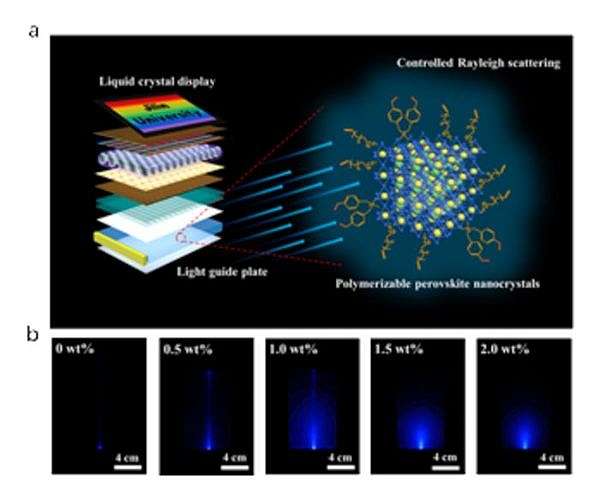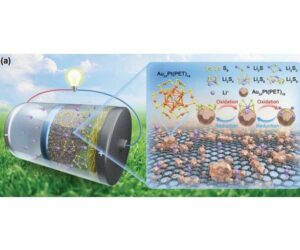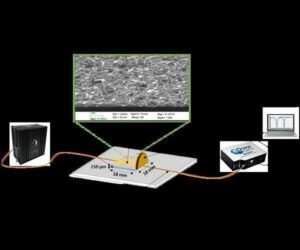
Breakthrough in Nanocomposite Technology for Superior Light Guides
by Staff Writers
Changchun. China (SPX) Nov 06, 2023
In a noteworthy development within the realm of nanotechnology and materials science, a group of researchers has introduced a new type of light guide plate (LGP) that incorporates perovskite nanocomposites (PNCs) into polymers to markedly improve liquid crystal display (LCD) illumination and uniformity. Their findings, detailed in a study published in “Light Science and Application,” demonstrate a pivotal step in enhancing the functionality and efficiency of LCDs.
The research team, spearheaded by Professor Bai Yang from the College of Chemistry at Jilin University in China, has employed a novel approach to tackle the challenge of dispersing PNCs evenly throughout a polymer matrix-a problem that has traditionally hampered the development of nanocomposites due to the high surface energy of PNCs which can lead to aggregation and phase separation.
To surmount this hurdle, Yang’s team used a two-ligand strategy that allows for the even distribution of PNCs within a polystyrene (PS) matrix, with one type of ligand assisting the dispersion of PNCs in the styrene and the other acting as polymerizable capping ligands. The result of this intricate process is a bulk CsPbCl3 PNCs/PS nanocomposite that maintains high transparency, even with a doping content as substantial as 5 wt%.
This transparency, essential for LCD applications, is attributed to Rayleigh scattering prevention, as the PNCs are uniformly distributed without significant aggregation. The research delves into the manipulation of this scattering behavior through the adjustment of the nanocomposites’ composition, thereby controlling the optical properties of the LGP.
By varying the composition of cesium lead halide PNCs, the researchers were able to systematically analyze the impact on LGP performance, focusing on factors like the volume scattering coefficient and optical radiation efficiency. The optimal LGP, doped with 1 wt% CsPbCl2.5Br0.5 PNCs, showcased a remarkable improvement in surface illuminance-around 20.5 times brighter-alongside 1.8 times higher uniformity in the display compared to a standard control.
These advances are not merely academic; they hold practical, far-reaching implications for the industry. The LGP developed by Professor Yang and his colleagues is fully compatible with current advanced LCD technologies, signaling a potential leap in display quality and energy efficiency.
Given the LGP’s enhanced performance metrics, the potential applications in LCD-related fields are expansive. The technology could be particularly revolutionary when integrated with advanced LGP processing technologies, like micro-optical patterns or wedge-shaped plates, broadening the horizon for more sophisticated display systems.
As LCDs continue to be a mainstay in screens across a multitude of devices, from smartphones to large-scale televisions, the integration of this novel LGP technology could represent a significant stride towards higher-quality, more efficient displays. This development is a clear indicator of the dynamic and ongoing evolution in materials science, opening up new possibilities for the future of display technologies.
Research Report:Bulk CsPbClxBr3-x (1?=?x?=?3) perovskite nanocrystals/polystyrene nanocomposites with controlled Rayleigh scattering for light guide plate
Related Links
Changchun Institute of Optics, Fine Mechanics And Physics
All About Solar Energy at SolarDaily.com
- SEO Powered Content & PR Distribution. Get Amplified Today.
- PlatoData.Network Vertical Generative Ai. Empower Yourself. Access Here.
- PlatoAiStream. Web3 Intelligence. Knowledge Amplified. Access Here.
- PlatoESG. Carbon, CleanTech, Energy, Environment, Solar, Waste Management. Access Here.
- PlatoHealth. Biotech and Clinical Trials Intelligence. Access Here.
- Source: https://www.solardaily.com/reports/Breakthrough_in_Nanocomposite_Technology_for_Superior_Light_Guides_999.html
- :has
- :is
- :not
- $UP
- 06
- 1
- 20
- 8
- a
- Able
- About
- academic
- across
- acting
- Adjustment
- advanced
- advances
- aggregation
- allows
- analyze
- and
- Application
- applications
- approach
- ARE
- AS
- assisting
- At
- BE
- behavior
- breakthrough
- by
- CAN
- challenge
- chemistry
- China
- clear
- colleagues
- College
- compared
- compatible
- composition
- content
- continue
- control
- controlled
- controlling
- could
- Crystal
- Current
- demonstrate
- detailed
- developed
- Development
- Devices
- Dispersion
- Display
- displays
- distributed
- distribution
- due
- dynamic
- efficiency
- efficient
- employed
- energy
- energy efficiency
- enhanced
- enhancing
- essential
- Ether (ETH)
- Even
- evenly
- evolution
- expansive
- factors
- far-reaching
- Fields
- findings
- fine
- focusing
- For
- from
- fully
- functionality
- future
- given
- Group
- guide
- Guides
- High
- higher
- Highlight
- his
- hold
- horizon
- http
- HTTPS
- hurdle
- Impact
- implications
- improve
- improvement
- in
- incorporates
- Indicator
- industry
- Institute
- integrated
- integration
- into
- intricate
- introduced
- jpg
- large-scale
- LCD
- lead
- Leap
- light
- like
- Liquid
- maintains
- Manipulation
- materials
- Matrix
- mechanics
- merely
- Metrics
- more
- more efficient
- multitude
- nanotechnology
- New
- noteworthy
- nov
- novel
- of
- on
- ONE
- ongoing
- opening
- optics
- optimal
- or
- Other
- particularly
- patterns
- performance
- phase
- pivotal
- plato
- Plato Data Intelligence
- PlatoData
- polymer
- Polymers
- possibilities
- potential
- Practical
- Prevention
- Problem
- process
- processing
- Professor
- properties
- published
- quality
- Radiation
- realm
- remarkable
- report
- represent
- research
- researchers
- result
- revolutionary
- s
- Science
- screens
- showcased
- significant
- smartphones
- solar
- solar energy
- sophisticated
- spearheaded
- spx
- Staff
- standard
- Step
- Strategy
- stride
- Study
- substantial
- superior
- Surface
- Systems
- tackle
- team
- Technologies
- Technology
- that
- The
- The Future
- their
- thereby
- These
- they
- this
- Through
- throughout
- times
- to
- towards
- traditionally
- Transparency
- type
- university
- used
- varying
- volume
- were
- when
- which
- with
- within
- without
- X
- zephyrnet












